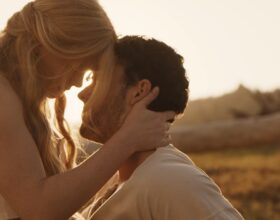 By Jacob Sahms
By Jacob Sahms
“War is hell.”
So said Union general William Tecumseh Sherman of the battles he fought in the midst of the American Civil War. While 1917 tells the story of a different war fifty years later, director Sam Mendes’ translation of stories his grandfather told about World War I shows us a hellish battle to be “the last man standing.” Yes, the film’s cinematography is beautiful, but the story told there is brutal and unrelenting.
By now, you’ve probably seen the trailer with General Erinmore (Colin Firth) warning a two young lance corporals about the German plan, Operation Alberich, which saw the German forces intentionally withdraw to lure Allied forces deeper into German-occupied France. You’ve seen rich camera shots of the battle, and young actor George MacKay in a few action shots. The beautiful cinematography of Roger Deakins (The Shawshank Redemption, A Beautiful Mind, Skyfall) can be glimpsed in those moments, but what can’t be fully grasped without seeing the span of the film is the way that Mendes allows us to soak up the “ordinary” young soldiers in the midst of a far-from-ordinary moment.
The film revolves around the quest of those two young soldiers going into the teeth of the action to stop a British force from overextending themselves and being destroyed. The fact that one of the soldiers has a brother (Game of Thrones’ Richard Madden) in the regiment that is going to be overwhelmed provides a drop of personalization for a film that aims to show the audience the scope of what war does. It allows the audience to see the conflict through the eyes of the younger brother (Dean-Charles Chapman) and the fellow soldier he chooses to take with him on this mission (MacKay). And it visually conveys the loss – of rifle, canteen, uniform – of the progression through the mission.
 This is no video game glamorization of war, where the soldiers “level up” and righteously celebrate their “wins,” but a reality-check for the warmongering in our souls, a reminder that the cost is born in the lives of those who die and the lives of those who come back, changed. We’re changed, too, by our systemic acceptance of war that keeps us safe and comfortable, changed by the shocking intimacy of the violence we’re shown, against a ruined French background and bodies strewn like trash along the path, as the casual ordinariness of the two young men is stripped away visually, and spiritually. Quietly, the film calls out to us:
This is no video game glamorization of war, where the soldiers “level up” and righteously celebrate their “wins,” but a reality-check for the warmongering in our souls, a reminder that the cost is born in the lives of those who die and the lives of those who come back, changed. We’re changed, too, by our systemic acceptance of war that keeps us safe and comfortable, changed by the shocking intimacy of the violence we’re shown, against a ruined French background and bodies strewn like trash along the path, as the casual ordinariness of the two young men is stripped away visually, and spiritually. Quietly, the film calls out to us:
“War strips the souls out of those who fight.
“War provides an opportunity for courage in the face of absolute fear.
“War pits young man against young man, even though both would rather live than kill.
“War leaves children orphaned.
“War is measured by winners and losers, but the soldiers who fight have all lost people who were more than names and serial numbers.”
1917 reminds us that wars may be remembered as “great,” but they are all built on the backs of people who suffered and died in the middle of conflict. It shows more than it tells, but some of its sparse dialogue reminds us of the fruitlessness of the endeavor when measured in casualties.
“Have we been fighting for three years for this?” one soldier asks no one in particular.
One colonel tells an unsuspecting subordinate, “we’ve been pulled back for now, but tomorrow they’ll change their mind and order us to attack again.”
The cycle continues, with the separation of those risking everything supremely clear from the powers that be who send them into the gap. The ordinary man in his ordinary time returns, but everything has changed, and everyone has lost something. It’s a chilling reminder, a cinematic warning about turning too quickly to conflict in our own lives and the glib way which we sometimes send men and women to fight for king or country, counting casualties solely as numbers and not names.




